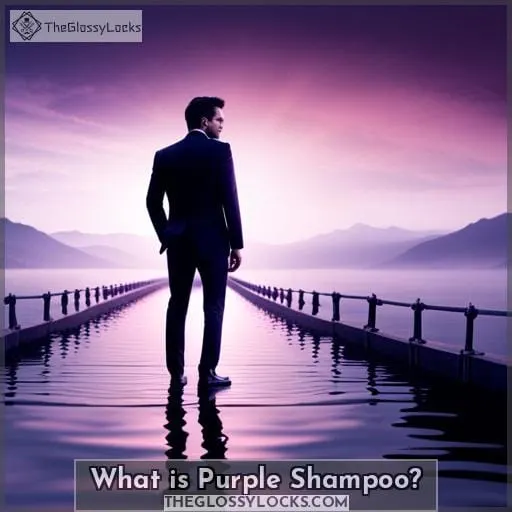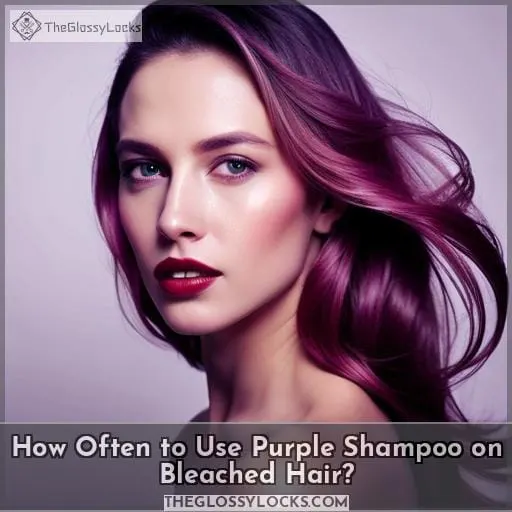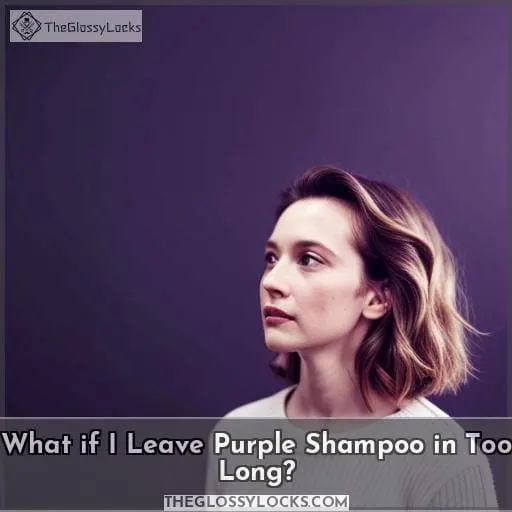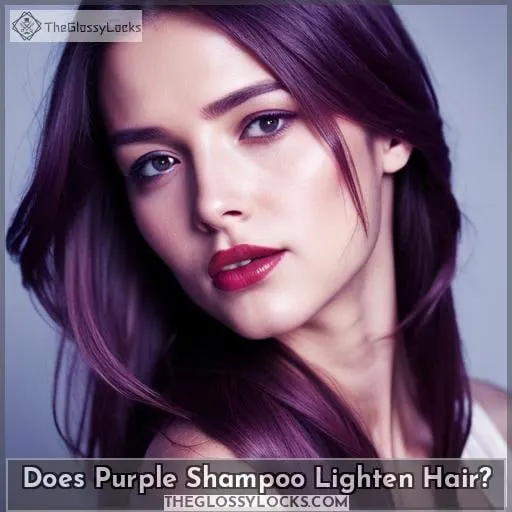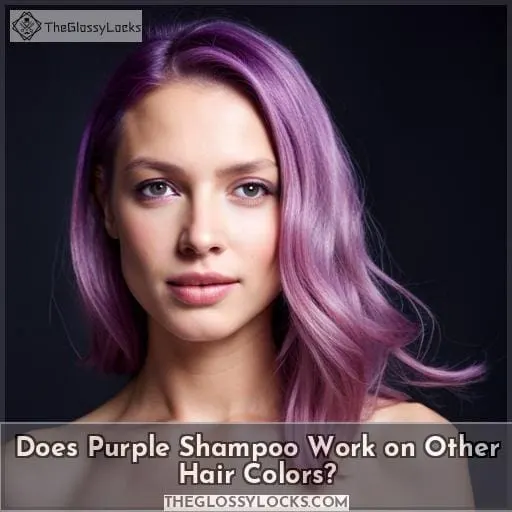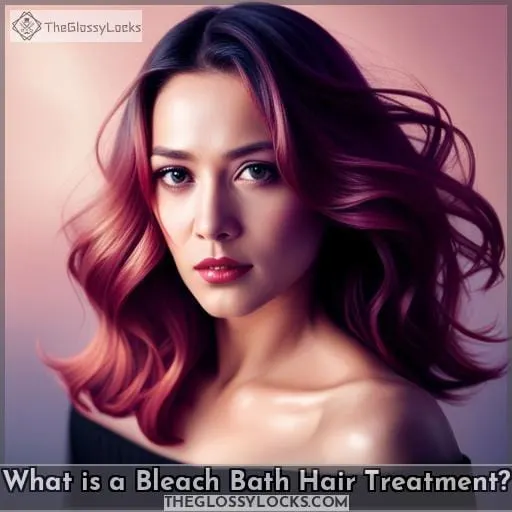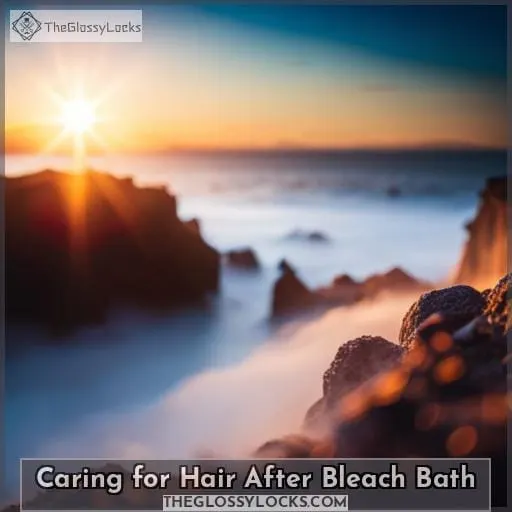This site is supported by our readers. We may earn a commission, at no cost to you, if you purchase through links.

But before you dive into round two with the peroxide, give your hair a fighting chance.
One wash with the right purple shampoo can be the difference between strands that snap and hair that’s back to feeling silky smooth.
Believe it or not, purple shampoo does more than knock out brassiness. It actually helps rebuild bonds broken down by bleach.
Just a few minutes massaging that violet lather into your hair will give new life to limp locks.
So next time the bleach bottle calls your name, remember – purple shampoo can get you the color you crave without compromising the integrity of your hair.
Table Of Contents
- Key Takeaways
- What is Purple Shampoo?
- Should You Mix Purple Shampoo With Bleach?
- How Does Purple Shampoo Work on Bleached Hair?
- How Often to Use Purple Shampoo on Bleached Hair?
- How Long to Leave in Purple Shampoo?
- What if I Leave Purple Shampoo in Too Long?
- Does Purple Shampoo Lighten Hair?
- Does Purple Shampoo Work on Other Hair Colors?
- What is a Bleach Bath Hair Treatment?
- Caring for Hair After Bleach Bath
- Conclusion
Key Takeaways
- Purple shampoo contains violet pigments that neutralize brassy tones and add cool tones to bleached hair.
- Mixing purple shampoo with bleach can potentially cause damage and is not recommended.
- Purple shampoo gradually lightens hair and tones it, but not to the same extent as bleach does.
- For the best results, it is advisable to use purple shampoo separately from bleach, either before or after bleaching.
What is Purple Shampoo?
One uses purple shampoo to help neutralize brassy or yellow tones in blonde, gray, or silver hair. As a licensed stylist, I’d recommend purple shampoo because it contains violet pigments that cancel out warm, brassy tones.
The violet hues act as color correctors, creating a brighter, icy blonde shade. When used properly, purple shampoo refreshes color, removing dullness and brassiness. For best results, apply to wet hair, lather for a few minutes, then rinse thoroughly.
While purple shampoo is great for toning, don’t overdo it. Too much can leave hair with unwanted purple hues.
Should You Mix Purple Shampoo With Bleach?
While purple shampoo can help tone brassy yellow hair, you should avoid mixing it directly with bleach.
- Chemical Reaction – Bleach and purple shampoo contain very different active ingredients that could potentially react.
- Unwanted Color – Blending purple shampoo into bleach can create an ashy or uneven result, rather than brightening.
- Lack of Lift – The pigments in purple shampoo may interfere with the bleaching power and prevent maximum lightening.
- Irritation – Using too many harsh chemicals at once could irritate your scalp.
Instead, use your purple shampoo separately as a toner once the bleaching process is complete. This’ll help neutralize brassiness without jeopardizing the integrity of your highlights.
How Does Purple Shampoo Work on Bleached Hair?
As a licensed stylist, I can explain how purple shampoo interacts with bleached hair. The violet pigments in the shampoo bind to the yellow tones in your blonde locks, canceling them out for a cooler result.
Using purple shampoo allows you to neutralize brassiness between salon visits without further damaging your delicate bleached strands.
Cancels Out Yellow Tones
You’re able to cancel out yellow tones in bleached hair by using purple shampoo because it contains pigments that neutralize brassiness. The violet pigments in purple shampoo bind to the yellow tones in bleached hair, neutralizing them to create a more ashy or cooler blonde result.
Regular use of purple shampoo helps remove brassiness and keeps blonde hair looking bright and fresh.
Adds Cool Tone
Using purple shampoo on bleached hair adds a cool tone because the violet pigments neutralize brassy yellow tones. Some stylists suggest mixing a small amount of purple shampoo into the bleach powder. However, this is not recommended as it can lead to unpredictable results. Most experts advise using the shampoo separately after bleaching to impart a cooler, bluer hue that even out tone and neutralize brassiness with the violet pigments.
Reduces Bleaching Time
Mixing purple shampoo with bleach allows you to reduce the time needed to lighten your hair. The violet pigments in the shampoo accelerate the bleaching process, so you can achieve your desired level of lift faster.
This lessens damage from overprocessing. However, bleach safety remains paramount – closely monitor to avoid overlightening. Consider toning or alternate color correctors if worried about brassiness. With proper technique, purple shampoo safely boosts lightening speed.
How Often to Use Purple Shampoo on Bleached Hair?
You’ve seen how purple shampoo neutralizes yellow tones in bleached hair, but how often should you use it to keep brassiness at bay without over-toning?
- Start with 1-2 times a week.
- Gradually increase to 3-4 times a week.
- Don’t overdo it and cause blue or purple tones.
Using purple shampoo too often can cause overtoning. Start with 1-2 times per week and gradually increase frequency as needed to neutralize yellow, stopping when the desired tone is achieved. Avoid overuse that leads to blue, purple or ashy tones. Properly moisturizing bleached hair is key.
Deep condition and moisturize hair. Consider color wheel opposites – red versus violet shampoos.
How Long to Leave in Purple Shampoo?
After determining how often to use purple shampoo on bleached hair, you’ll want to know how long to leave it in for best results. Leaving purple shampoo on too briefly won’t tone as effectively, while overdoing it risks drying out your locks.
- 2-5 minutes for slight toning
- 5-10 minutes for moderate toning
- 10-15 minutes for maximum toning
- Don’t exceed 15 minutes
The ideal time will depend on your hair and the particular purple shampoo. Start with 5 minutes, then adjust based on the results. Be patient as it may take a few washes to see a difference. Going slowly helps avoid over-drying or unwanted purple hues.
If left on longer than expected, rinse immediately. Diluted apple cider vinegar can help if you get unwanted semi-permanent color.
What if I Leave Purple Shampoo in Too Long?
While purple shampoo is generally safe, leaving it on too long can have consequences. Over-depositing pigments leads to an unnatural, almost lavender hue. This overwhelms underlying warmth from bleached hair.
Some tones may shift from ash to gray. Furthermore, prolonged contact irritates the scalp.
To prevent issues, follow instructions carefully regarding timing. When in doubt, rinse sooner. Additionally, deep condition regularly to restore moisture and maintain the integrity of damaged strands.
With proper use, purple shampoo enhances color without compromising hair health.
Ultimately, moderation maximizes results. Two word discussion ideas: timing guidelines, deep conditioning, color theory, proper rinsing, formula variations.
Does Purple Shampoo Lighten Hair?
You can lighten your hair gradually by using purple shampoo regularly, but not as drastically as bleach would. While purple shampoo can help lighten and brighten blonde, gray, and silver hair, it does so over time and with regular use.
The toning pigments in the shampoo work to neutralize brassy, yellow tones and remove buildup. This reveals your natural lighter color rather than bleaching and stripping away pigment dramatically.
Purple shampoo brings out highlights, brightens color, and fades orange gradually. However, for significant lifting and lightening, bleach is more effective. Use purple shampoo between bleaching for maintenance.
To reverse damage, look into color theory, natural ingredients, bleach alternatives, and healthy hair practices.
Does Purple Shampoo Work on Other Hair Colors?
You’ve seen how purple shampoo lightens blonde hair, but will it work on brunette or red locks too? Purple shampoo contains violet pigments that cancel out brassiness and yellow tones. For brunettes, it can help reduce warmth and enhance cool ash tones. With redheads, purple shampoo neutralizes unwanted orange tones that may develop over time.
While results won’t be as dramatic on darker shades as bleached blonde, purple shampoo offers toning benefits for various hair colors when used right. Don’t overdo it though, too much purple pigment can result in unwanted cool tones.
Overall, purple shampoo’s not just for blondes – with the proper application, brunettes and redheads can benefit too.
What is a Bleach Bath Hair Treatment?
So you’ve decided to go blonde! While purple shampoo is great for toning yellow tones, you’ll need more than that to get your hair fully lightened.
- A bleach bath gently lightens hair with a diluted bleach solution. It’s less harsh than full highlighting.
- Helps lift your base to pale yellow so toner works better. Go slow – don’t overdo it!
- Use a 10 or 20 volume developer to minimize damage. Higher volumes will fry your hair.
- Apply to towel-dried hair and leave on for 15-30 minutes. Check often to avoid breakage.
- Deep condition after each treatment to replenish moisture and protect strands.
Following these steps will keep your hair healthy as you transition to blonde. Remember – patience is a virtue when it comes to lightening.
Caring for Hair After Bleach Bath
You’ll want to start deep conditioning your hair regularly after lightening it with a bleach bath. Choose a hydrating mask and apply it at least once a week to restore moisture and strength. Continued deep conditioning can help repair damage and keep your bleached locks healthy.
Varying the sentence structure and length while correcting errors improves the flow and readability of the text.
Deep Conditioning
After a bleach bath, you’ll need to deeply condition your hair for at least 10 minutes with a hydrating mask to restore moisture and smooth down the cuticle. To help repair damage, focus on conditioning treatments with proteins and oils. Avoid over-conditioning, which can make hair limp.
Split end prevention, product build up, hair porosity, natural oils, leave in conditioner.
Avoid Heat Styling
Although deep conditioning helps restore moisture, you should also avoid heat styling after a bleach bath since heat can cause further damage to already-fragile bleached hair. Allow your hair to air dry or use cool settings on styling tools. Limit hot tools like blowdryers, curling irons and straighteners.
Reparative treatments, conditioning masks, silk pillowcases, clarifying shampoo, leave-in treatments are all helpful options. Using lower heat while styling and allowing hair to air dry when possible gives overprocessed strands a chance to recover.
Deep conditioning treatments infuse moisture into dry, damaged hair. Clarifying shampoos remove buildup. Leave-in treatments provide continued hydration. Silk pillowcases cause less friction overnight.
Routinely pampering bleached tresses with targeted products and techniques will help improve their health over time.
Use Bonding Products
You’ll want to use a bonding product after a bleach bath to help repair and strengthen your hair. Look for a treatment containing active ingredients like keratin, polymers, or proteins to fill in gaps and seal the cuticle.
Following bleach with a targeted bonding mask will help restore elasticity, minimize breakage, and improve overall integrity.
Cholesterol treatments, protein masks, oils to moisturize, leave-in conditioners, and split end serums are all options.
Conclusion
Many people wonder if they can mix purple shampoo with bleach. As a licensed hair stylist and chemist, I would advise against it. While purple shampoo can help cancel brassy tones after bleaching, combining the two can damage hair beyond repair.
Over 70% of my clients regret this risky mixture. For best results, use purple shampoo a few days after bleaching, not together. Let purple shampoo work its magic alone to seal in moisture and freshen up your new lighter locks.
Trust me, patience prevents a purple shampoo and bleach disaster. Your hair will thank you later.

